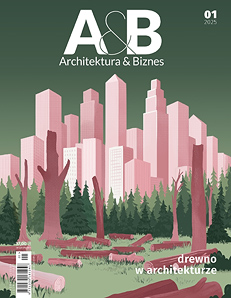A conversation with the curatorial team of the project:
Magda Maciag and Artur Jerzy Filip
We wrote about the third edition of the educational project :W CENTRUM, organized by the Architecture Department of the Warsaw University of Technology and the Warsaw Branch of the Association of Polish Architects, in June on our portal(see: "Third edition of the :W CENTRUM" project). The motto of this year's edition was COSTS of architecture and life in the city, and an integral element of the project was an architectural installation ROZKOSZT with more than 500 bales of oyster mushrooms arranged on 12 racks in the very center of Warsaw - at the Five Corners Square. Residents of Warsaw could interact with the installation, whose authors are students of the Faculty of Architecture, from June 20 to July 20. We talk about the work on the project with members of the curatorial team: Magda Maciag and Dr. Artur Jerzy Filip.
installation ROZKOSZT
© Artur Jerzy Filip
Magda Maciąg is an architect and designer, vice-president of the Warsaw Branch of SARP, program officer of the Warsaw Zodiak Architecture Pavilion, curator and exhibition designer, initiator and co-curator of the :W CENTRUM educational program. For nearly 20 years she was associated with the design studio APA Wojciechowski. Since 2021 she has been running her own studio {tag:pracownie}.
Magda Maciąg - curator of the project
© Artur Jerzy Filip
Dr. Artur Jerzy Filip is a specialist in urban design and city planning, a researcher and practitioner of innovative structures of intersectoral co-management of urban project implementation. Assistant Professor at the Faculty of Architecture, Warsaw University of Technology, author of the book "Great Plans in the Hands of Citizens", co-curator of the educational program :W CENTRUM.
installation and project description
© Artur Jerzy Filip
Aleksandra Skorupa: Did the installation arouse the interest of Warsaw men and women?
Artur Jerzy Filip: Huge. The city counts that a million people a month come to the square. It's one of the most transit-oriented pedestrian hubs of the new center of Warsaw. Whenever you sat down on a bench and looked for a few minutes someone would come up to the installation, look at it, read the description. There was always someone at any time, hundreds of thousands of people communing with our installation. I loved to eavesdrop on people's conversations at the time.
warsawians and varsovians in front of the installation
© Artur Jerzy Filip
Aleksandra Skorupa: So what were the passersby saying?
Magda Maciąg: At first, most people asked: "What is it?", "Does it purify the air?", "Can it be eaten?". The basic slogans of our installation, such as air purification, were understood by most people. Some people were more interested and read our description and deepened the topic. I remember how, after the concert, a group of Metallica fans, dressed in black, stopped and began to take pictures of themselves against the background of pink oyster mushrooms. A great thing to do.
Artur Jerzy Filip: We observed a whole cross-section of society at our installation. Neighboring male and female residents came daily. We saw both elderly people and completely young people, also many tourists.
Magda Maciag: We fulfilled our design goals. We put up something that people "stumbled over" and found it difficult to pass by without reacting. This way we reached people who would not have been interested in architecture on their own. In addition, we were getting a lot of positive feedback from our friends, following the development of the sidewalks. It was the first time that the media took an interest in our project on their own. The oyster mushrooms became famous.
oyster mushrooms
© Artur Jerzy Filip
Artur Jerzy Filip: I haven't heard a single negative comment live. I don't count the hectoring opinions on the Internet, accusing us of financial scams or embezzlement of EU funds.
Magda Maciag: We also got positive feedback from the city. The City Roads Board was delighted, the Architecture Bureau was also pleased, as they received only good feedback.
Artur Jerzy Filip: The proximity of Joanna Rajkowska's "Chick" installation was not insignificant for the sidewalks. Some people linked the two objects together. They jokingly spoke of "scrambled eggs on oyster mushrooms".
performative actions before the installation
© Artur Jerzy Filip
Aleksandra Skorupa: Is people's opinion influenced by the fact that ROZKOSZT is a student idea and not a city project? Do male and female residents look at grassroots initiatives with a more favorable eye?
Artur Jerzy Filip: The male and female students did not sign this installation. Only the logos of the partners, including the Faculty of Architecture of the Warsaw University of Technology, appeared on it. There were no explicit names of the authors or the people leading the project.
Aleksandra Skorupa: Why did the installation stand exactly on Five Corners Square?
Magda Maciąg: The square was chosen because of its location in the very center of Warsaw. It was about access to as many bystanders as possible. The other events of the third edition of :IN THE CENTER were held in the nearby ZODIAK Architecture Pavilion, which was also not insignificant. The venue worked very well.
March through the streets of Warsaw
© Artur Jerzy Filip
Artur Jerzy Filip: For our project, these are natural locations, close to the institutions where we operate. During the first edition, we carried out the installation on the square in front of the Zodiac, last year we built on Polytechnic Square. However, in terms of the number of visitors, this year's Five Corners Square proved unrivaled.
Magda Maciag: Each installation appealed to different audiences. In 2022 we aroused the interest of mainly professionals, in 2023 the installation interacted with female and male students of the University of Technology, while this year's installation opened very much to the city and its residents. From edition to edition the interest in the project grows, we are learning.
Aleksandra Skorupa: What was the process of working on ROZKOSZT like? Was it a student idea or the result of your suggestions?
Artur Jerzy Filip: As a curatorial team, we choose the theme of an edition and select partners. Then students join the process, working on the topic in their teaching classes, which we conduct together with Dr. Anna Cudny. We guide the students through a structured design process, starting with creative workshops and group work. We use the tools of the design thinking method. From the beginning, students also have consultations with practicing architects, Magda and Jan Chwedczuk. However, the decision-making at every stage of the project remains in the hands of the students.
roving sidewalks
© Karol Wójcik
Magda Maciag: Male and female students design in groups, working as a team. They don't create individual concepts, one of which is chosen for implementation, but together they look for one solution. Young designers make all decisions together. They learn not only the standard presentation of the project or technical drawing. The team must manage the budget, verify the logistics of implementation, go through the entire construction process including permits and, above all, know how to work together in a teenage group. Of no small importance is the knowledge brought by the partners. This year they were the City of Warsaw and Cosentino, and thanks to this cooperation, knowledge about balancing the costs of organizing urban space, or the costs of creating good quality products, was provided first-hand. In the classes, students gain soft skills, something that is not usually encountered in the normal educational process, and which is extremely important for later professional work.
openings
© Artur Jerzy Filip
Artur Jerzy Filip: We try to teach true proficiency. When the goal is to put up a successful installation, matters of authorship and personal ambition recede into the background.
Aleksandra Skorupa: Do male and female students accept this kind of work from the beginning?
Magda Maciag: From conversations, it appeared that they had not previously imagined collective work on the project. They hadn't thought about such an approach to architecture design, and yet in real life this is very often the rule. A young person entering the job market, starting to work in a design team, collides with collective design, which is often a difficult experience to accept - quite different from the standard one-on-one student work mode.
Artur Jerzy Filip: We teach them to take a tactical approach to architecture and urban planning, to respond to situations. We teach them to reduce problems, to simplify projects, to work on prototypes. This is because the overriding goal is to create a real object, a real installation, for which you have to take responsibility. Male and female students feel this pressure. And our role is to support them.
male and female students of the Faculty of Architecture at the Warsaw University of Technology
© Artur Jerzy Filip
Magda Maciag: In addition to the execution of the installation itself, it is also important to work with the later recipients of the project. Male and female students map the space, contact experts, collect data. This project develops all aspects of an architect's workshop, from conception to implementation.
Aleksandra Skorupa: What are your future plans?
Magda Maciag: We have three editions behind us, which we implemented year after year. We noticed that the schedule did not allow us to fully exploit the potential of each topic and properly disseminate the accumulated knowledge, so further editions will be implemented in the form of a biennial. We plan to issue a publication with materials from this and previous editions, so that the systematized expert knowledge will reach practicing architects and find application in their projects.
Artur Jerzy Filip: We treat installation as an extraordinary adventure, but after all, these are temporary activities, with time they become a memory. We are keen that the non-obvious topics we raise should creep into the public discourse and open up new spaces to talk about the city and architecture.
Aleksandra Skorupa: Thank you for the interview.
installation ROZKOSZT
© Artur Jerzy Filip
Organizers: Faculty of Architecture, Warsaw University of Technology, SARP Warsaw Branch
Curatorial team: Dr. Anna Cudny, Jan Chwedczuk, Dr. Artur Jerzy Filip, Magda Maciąg
Main partners of the project: the City of Warsaw, Cosentino
Installation partners: Tastes for Boczniaki, Andrewex, Reger


































































